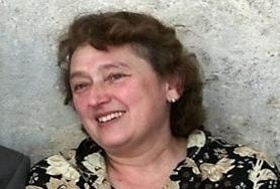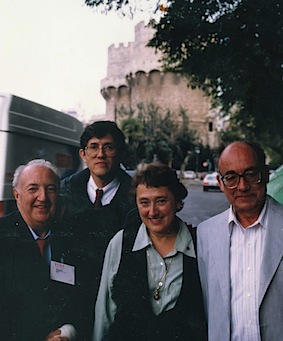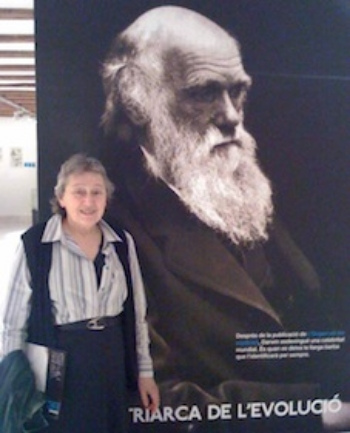
Since Darwin times, evolution was considered a race in which species compete to continue in the race, as in the “Red Queen’s Race” in the book Alice through the looking glass. In this work by Lewis Carroll, Alicia travels to the country of the Red Queen, in which all its inhabitants must always be running as much as possible to stay in place, since the country is also moving. However, a century later, some contributions that Lynn Margulis (1938-2011) made to biology showed a different view of evolution: it is also a race, but the bodies that do not abandon it and who move forward the most are not those who compete with others, but those who come together to collaborate with a shared purpose. For her, the true engine of evolution is cooperation. Her unlimited curiosity led Margulis to investigate forgotten or unknown authors in scientific literature and rescued some ideas about the symbiosis that a few Russian researchers had outlined, but had gone unnoticed. In spite of the obstacles she encountered, she did not desist until she showed that the evolution also had a friendly face, that of a world where collaboration is successful.

Lynn Margulis and Stanley Miller.
Image source: Mercè Piqueras.
Many scientists make the great discovery of their lives after many years of experimental work. The case of Margulis was very different. The theory – only a hypothesis then – of the symbiogenesis that made her famous occurred to her when during her doctorate studies at the beginning of the 1960s. It is a theory that explains the origin of the eukaryotic cell (the one that has the genetic material contained in a compartment that we call nucleus) from symbiotic relations (of cooperation) between prokaryotic cells (those that have the genetic material dispersed inside the cell, without a differentiated nucleus). At some point in the history of life, some predatory cells, instead of consuming their prey, established a new relationship that benefited one another.
The concept of symbiosis or dual hypothesis was known since the 19th century, when Simon Schwendener (1829-1919) and Anton de Bary (1831-1888) studied the dual nature of lichens, which are living organisms formed by the union of a fungus and a seaweed. An idea that was first received with skepticism, but that had to be accepted before the evidence provided by many botanists who isolated algae that are associated with various types of fungi to form the different “species” of lichens. Schwendener described that association as one of dominance of one organism over another. But it was actually a union from which both members were benefited. Albert Bernhard Frank (1839-1900) coined the term symbiotismus (symbiosis), which was neutral, to make it clear that it was not a case of parasitism, in which one of the organisms is harmed. And Anton de Bary was the first to publicly use this term (at a lecture he gave in 1878), which is why the minting is often attributed to him.
With her theory of endosymbiosis, presented to the scientific community in a publication in 1967 (the author was then twenty-nine years old), Margulis staggered the foundations of cellular biology and introduced a new vision of evolution, in which cooperation can be just as valuable as competition or more. According to that theory, the eukaryotic cell (the cell with nucleus) would have formed from symbiotic unions in which a bacterium (prokaryotic organism, without nucleus) was integrated into a larger one. It was possibly a predatory cell that, instead of destroying the cell that had ingested, incorporated it into its cytoplasm and established a union the two were benefitted from. The development of molecular genetics allowed years later to prove that daring hypothesis, which no one questions today.

In 1965, Margulis formulated her hypothesis on the endosymbiotic origin of the eukaryotic cell. She wrote an article about it that was rejected by fifteen magazines, until in 1967 it was accepted by the Journal of Theoretical Biology. (According to the declaration of Margulis years later, the rejection was not solely because it presented a revolutionary hypothesis, but because it was poorly written and poorly presented.) The first decades of her career Margulis investigated only on eukaryotic microorganisms and she became an expert on them. The world of prokaryotes remained a mystery to her because she was not interested in microbiology’s vision of bacteria, which were fundamentally studied as a cause of diseases. She considered that there was a biased view of them because, without much in-depth study of microbial communities, it becomes clear that pathogenic bacteria are a very small minority of this great invisible world that surrounds us and that live with us and with all other living beings.
From 1983, when she began her collaboration with microbiologists from the Autonomous University of Barcelona, and from 1988, from the University of Barcelona, she went deeper into the knowledge of prokaryotes (bacteria) and their role to the biosphere. Lynn Margulis maintained her work and personal relationship with Catalonia for almost the last thirty years of her life (a link that also extended to Valencia, where she collaborated with professors of its university and where she was very much admired and appreciated by students). She was very interested in studies of the origin and in the evolution of life and the incipient science of microbial ecology and in some very primitive ecosystems that had already begun to be studied in Catalonia. First of all, the Cisó lake, in the Banyoles lakes complex, with an ecosystem that reproduces the conditions that the aquatic ecosystems of the Earth could have had in the early stages of biological evolution. Working at the Cison and some other ponds she participated in the research that led to the discovery of a predatory bacterium: Daptobacter. Depredation is a very rare behavior in the prokaryotic organisms and the presence of Daptobacter inside another bacterium it attacks and ends up destroying indicates that the phenomenon of the endosymbiosis that Margulis imagined had its foundation. Later, she participated in the studies of the microbial tapestries of the Ebro delta, another primitive ecosystem of the coastal zones, made up only of microorganisms. There, her research group isolated some new species, including the first spirochete found in an ecosystem of this type and then a giant spirochete, much larger than any of the known species of this group.
Margulis and other biologists of the late twentieth century have provided evidence that the most frequent interactions between all living beings are those of cooperation and symbiosis. Modern biology has shown that there are cases of symbiosis that are contingent and, depending on the environmental conditions, their members meet, live together for some time and then separate and re-live individually each on their own.
In collaboration with Karlene V. Schwartz, Margulis spread the classification of living beings in five major groups (prokaryotes, protists, fungi, plants and animals), which is compatible with the division into three large groups (archaea, bacteria and eukaryotes) that Carl Woese did later. It is also worth mentioning her contribution to Gaia’s theory of James Lovelock, who considers Earth as a system in which its inert components (the planet and its atmosphere) and the living interact and self-regulate. Margulis provided the biological bases to explain the interaction between living and non-living components of the Earth and how the current characteristics of the planet are the result of those interactions throughout its history.
Cover image source: Mercè Piqueras.
Personatges i espais de ciència (‘Science characters and spaces’) is a project of the Unit of Scientific Culture and Innovation of the University of Valencia, with the collaboration of the “López Piñero” Institute of History of Medicine and Science and with the support of the Spanish Foundation for Science and Technology and of the Ministry of Economy, Industry and Competitiveness.

.jpg)












